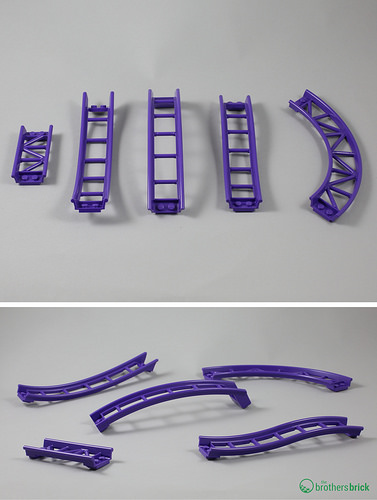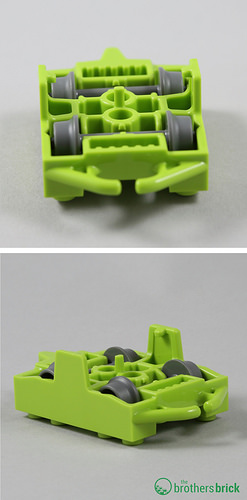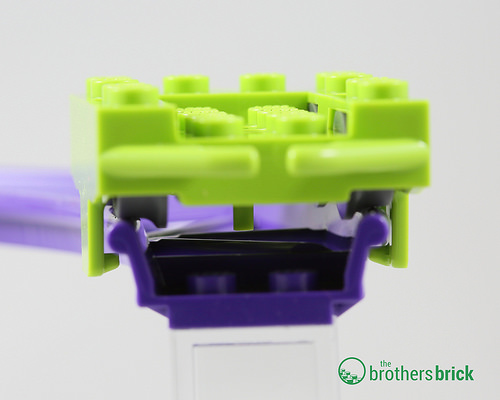LEGO has introduced an all new roller-coaster play system in 70922 The Joker Manor. We discussed it briefly in our review of the full set, but we felt the new roller-coaster rails were important enough to merit a post of their own. As one of TBB’s least Technic-centred members of staff, I found it was great fun attempting to add Power Functions to the rollercoaster and—health and safety aspects aside—it turns out it’s also rather simple.
First, a recap of the new purple tack sections supplied with The Joker Manor. The system includes five new rail sections — a short straight section, slight elevation, concave elevation, convex elevation, and quarter curve. There are two each of the first four rail sections shown and four of the quarter curve sections to complete a short loop around Joker Manor.
There are three rollercoaster cars in this set, and the cars themselves are constructed from a single Lime body part with two sets of wheels which simply click into place beneath the cars.
Importantly for this exercise, the underside of the cars has a central pin that extends between the track and allows the cars to connect with a Technic chain link to pull the car along. Other types of tread links may also be compatible, but the classic Technic chain was the only link style that I had in sufficient quantities to test. This pin clears the track struts, but only by a little. Here you can also see how the side panels descend to grip the track.
This pin clears the track struts, but only by a little. Here you can also see how the side panels descend to grip the track.
Discussion with other senior technical and engineering colleagues at TBB lead to the supply of this conceptual set of instructions, kindly provided to assist me in my Technic endeavours. Feel free to use these detailed instructions to build your own motorised LEGO rollercoaster. 
For this test setup, I kept things very simple with a Power Functions battery pack, a Power Functions M-motor, two gears that were in The Joker Manor and some Technic chain link.
My version of this upwards chain link portion is not perfect, I know, and I welcome suggestions to improve it. The main aim was to prove the concept that the rollercoaster could be powered using current Technic parts, rather than provide a perfect solution to the numerous issues of powering a LEGO rollercoaster.
To remove the ‘distraction’ of Joker Manor, I roughly set up the track in a complete loop using a selection of supports to hold key parts in place. During the series of tests, the height of each support could be easily altered by adding or removing plates to ensure that the cars would complete the circuit powered by momentum from the top of the hill. The tracks allow a bit of fudge in the system as they flex a little when connected in a complete loop.
To my great, child-like excitement, the test and setup worked and soon a LEGO rollercoaster was cruising around the track, connecting with the chain link (mostly without issue—although there were some crashes and derailments) and continuing on its winding journey. Success!
Now someone with more engineering knowledge and Technic construction skill can make it prettier and more effective…but it works!
I can’t wait to see where LEGO takes this new system. As we mentioned in the review of The Joker Manor, it’s our guess that a Creator Roller Coaster set is coming in the near future, though LEGO has yet to announce any future plans.
The LEGO Group sent The Brothers Brick an early copy of 70922 The Joker Manor for review. Providing TBB with products for review guarantees neither coverage nor positive reviews.






Is it possible to get detailed pics of the stud connection points of each track element?
This is amazing! I hope Lego will make those tracks and carts in different colours.
Ah, the Technic functions are only added for the uphill ride, and the downhill ride goes automatically. Clever!
@Hakan :-) I actually assumed that was how a rollercoaster worked (I could be wrong as I’ve never actually looked into this but the ‘coast’ part was why I assumed this was the case)
Well done! I assume the official motorized set will come with a guide or other part to keep the chain from rubbing against the track pieces.
Now, make monorail!!
maybe this was intentional.
The system works fine, but I would argue that the chain motor is a little too fast. The actual system will likely use the smaller motor.
I have 120 chains links. Will this be enough! Thanks for the great work
@Elspeth:
Yes, traditional roller coasters work in almost exactly that manner. You start with the car at what might be the lowest point in the track. Passengers board, and wheels mounted horizontally alongside the cars are used to push the group forward to the base of a tall incline. Wheels are used at this point instead of chain because this allows you to move each set of cars independently, so one set can be stationary for unboarding/boarding, while the set in front can be pushed forward and the set behind can be brought to a stop.
At the big incline, there would be a chain drive that pulls the entire set of cars all the way to the top and just a little further where enough of the weight is on a downward slope that gravity kicks in, and the cars start down what is usually a large decline. Inclines later in the ride _may_ have another chain drive if the cars need a bit of a boost, but generally speaking the cars should pick up enough momentum on that first drop to carry them through any rises or loops.
Small coasters like you find at pop-up carnivals (think Fairground Twister) could possibly ditch the chain drive altogether in favor of sideways wheels that may be used to just push the cars through a few times in a row before bringing them to a halt (small coasters can take much longer to board and unboard than doing a single lap, so repeat laps can help pad the experience).
Newer coasters can use other drive systems. I remember reading about a track system that used aluminum vanes that stick up between the rails to create a magnetic field that brings the cars to a halt as they pass by. I also know there’s at least one coaster that uses a launch system that probably feels like a jet taking off from a carrier deck’s catapult system. Instead of pulling you to the top of the incline, it shoots you up there. I don’t know if it’s done with a pneumatic/hydraulic ram, or if it’s done using railgun technology, but right from the start you’re probably moving faster than most traditional coasters when the hit the bottom of that first large hill.
I feel like this would cause some serious wear on both the tracks and the chain if run in a set up for too long. Hopefully someone can find a solution to this issue.
Great work on the chain drive! I wonder if a compress air launch system would be possible for a coaster also,love that Lego has provided a roller system opens many possibilities
OOO!!! There’s 30 of those little chain links in the the polybag of the mini ice tank!